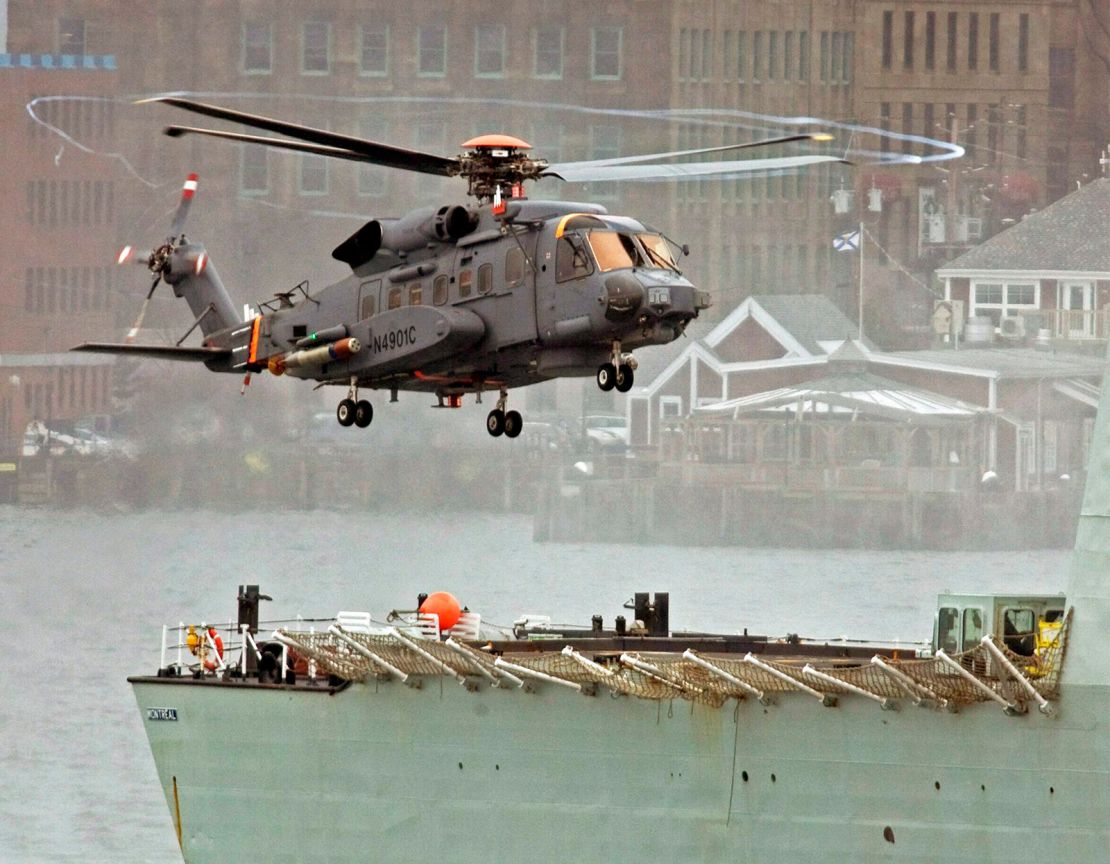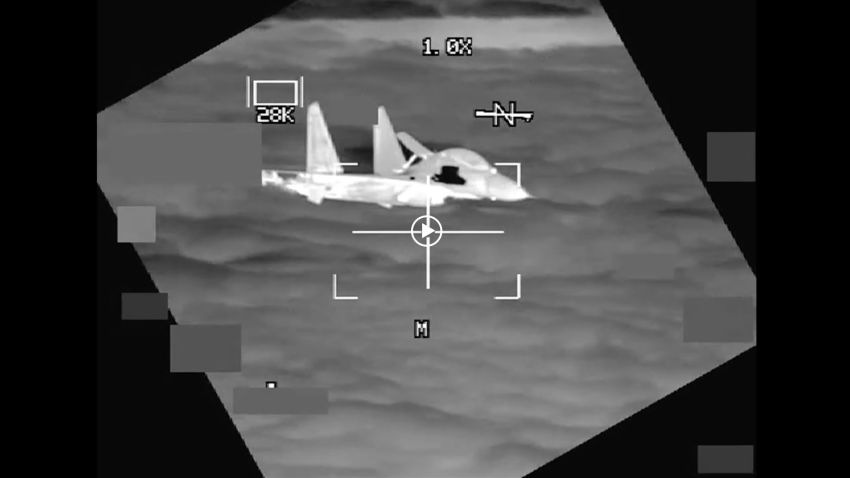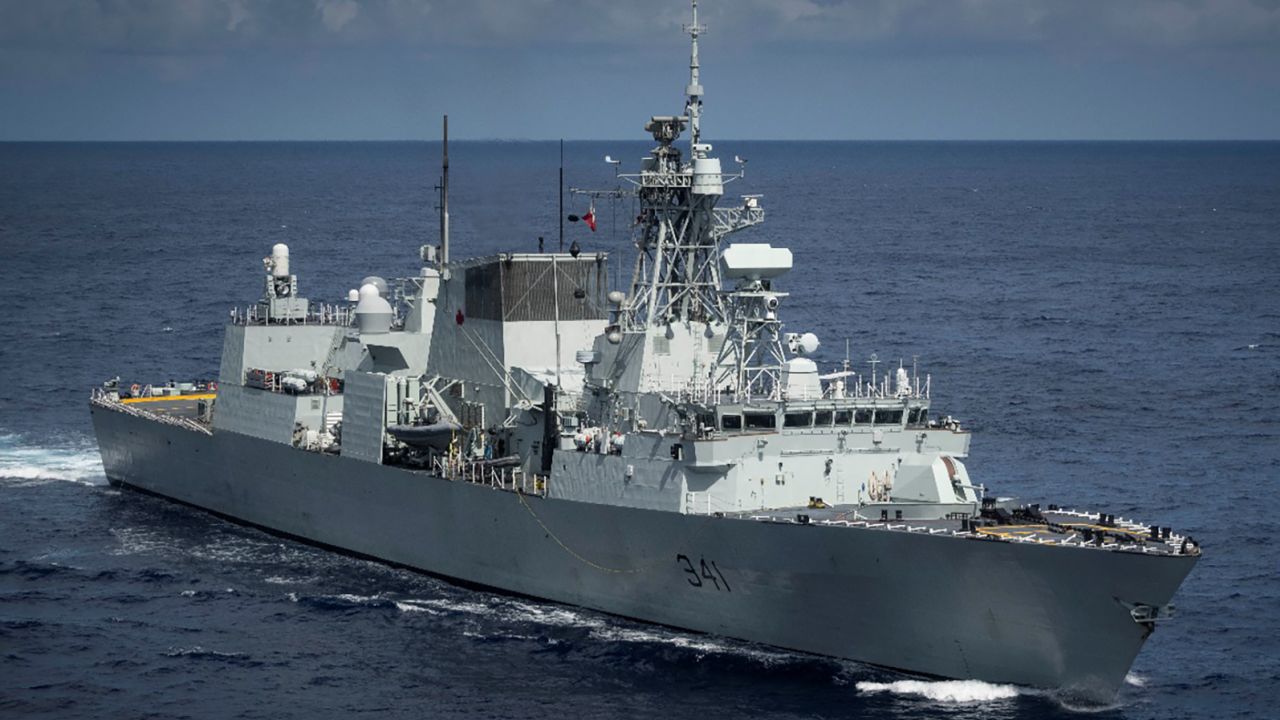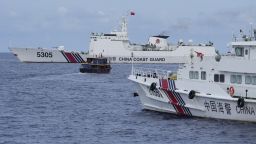A Chinese warplane fired flares in front of a Canadian military helicopter over international waters of the South China Sea last Sunday, an operation that Canadian military officers said was reckless and could have resulted in the downing of the aircraft.
“The risk to a helicopter in that instance is the flares moving into the rotor blades or the engines so this was categorized as both unsafe and non-standard, unprofessional,” said Maj. Rob Millen, air officer aboard the Royal Canadian Navy frigate HMCS Ottawa, the warship from which the Sikorsky Cyclone helicopter was flying.
The incident was the second of two encounters the Ottawa’s helicopter had with Chinese People’s Liberation Army Navy J-11 fighter jets over international waters on October 29, which saw the fighters get as close as 100 feet from the helicopter, Millen told CNN in an interview aboard the warship.
He said that Canada and other nations have seen Chinese aircraft get close to fixed-wing aircraft on numerous occasions, but it was rare to see such action taken against a helicopter.
The first incident was over international waters outside of 34 miles from the Paracel Island chain in the northern part of the South China Sea. The second was also over international waters outside of 23 miles from the Paracels. The warship was operating in international waters 100 miles (160 kilometers) east of the Paracels at the time.
The Canadian helicopter was searching for a previously detected submarine when the incidents occurred, officers aboard the Ottawa said.
Millen said he was piloting the Canadian helicopter earlier in the day, when Chinese J-11s intercepted it at close range while it flew straight and level at 3,000 feet above the water back toward the Ottawa, a signal to the Chinese that it had no hostile intent.

In that earlier encounter, Millen said the Chinese fighters flew in circles around his helicopter.
“When the intercepting aircraft was closer and closer, at a certain point it became unsafe,” he said.
His helicopter experienced turbulence coming off the Chinese jets, also posing a danger to the copter, Millen said.
“I certainly am not as comfortable as you can be based on the fragility of the rotor system,” he said.
Millen said he ended that encounter by descending to 200 feet, an area where the helicopter can operate but is “very uncomfortable for fast air fighter jets.”
The Canadian air force major said his military’s air crews train on how to respond to such intercepts as occurred on Sunday and will continue to fly over the international waters of the South China Sea.
Asked about the interception at a regular press briefing on Friday, Chinese foreign ministry spokesman Wang Wenbin replied: “I’m not aware of the situation you mentioned.”
“We have reiterated many times our firm position on Canadian warplanes conducting reconnaissance near China’s territorial airspace,” he told reporters. “We hope Canada will refrain from its inappropriate behavior to avoid the situation from becoming more complicated.”
CNN has also reached to China’s Defense Ministry for comment.
China claims historic jurisdiction over almost the entirety of the vast South China Sea, and since 2014 has built up tiny reefs and sandbars into artificial islands heavily fortified with missiles, runways and weapons systems – sparking outcry from the other claimants. The Paracels, called the Xisha Islands by China, are in the northern part of the South China Sea, east of Da Nang, Vietnam, and south of China’s Hainan Island.
The 1.3-million-square-mile waterway is vital to international trade, with an estimated third of global shipping worth trillions of dollars passing through each year. It’s also home to vast fertile fishing grounds upon which many lives and livelihoods depend.
In 2016, an international tribunal in The Hague concluded that China has no legal basis to claim historic rights to the bulk of the South China Sea. China has ignored the ruling.
Freedom of navigation
Major western powers frequently conduct passage across the sea in order to assert that the region is international waters, sparking Beijing’s ire.
The Ottawa had been patrolling the waterway since last Monday, at times operating with United States, Australian, Japanese and New Zealand naval vessels and aircraft in a multinational exercise dubbed Noble Caribou. However, it was operating alone when the encounters with the Chinese jets.
The Ottawa and the US Navy destroyer USS Rafael Peralta overnight Wednesday into Thursday local time continued their deployment into the Taiwan Strait, another international waterway and vital shipping channel that has seen tense
encounters between PLA and allied vessels.

Last June, the US Navy reported a close encounter between the destroyer USS Chung-Hoon and a Chinese warship during a Taiwan Strait transit, in which the US warship slowed down to avoid colliding with the Chinese navy vessel that cut in front of it. The Canadian frigate HMCS Montreal was accompanying the US ship at the time, and a news crew aboard it recorded the incident.
Then Chinese Defense Minister Li Shangfu blamed the US for ratcheting up tensions in the region when questioned by reporters at a defense conference in Singapore.
“They are not here for innocent passage, they are here for provocation,” Li said of US warships.
Li said if the US and other foreign powers did not want confrontation, they should not send their military assets near China.
“Mind your own business,” Li said, adding, “Why did all these incidents happen in areas near China, not in areas near other countries?”
This week’s passage of the allied warships through the strait was uneventful, however, with no contact reported.

Sunday’s incidents come after other reports of unsafe intercepts of allied aircraft in the recent days.
On Tuesday, a PLA fighter jet came within 10 feet of a US Air Force B-52 bomber flying over the South China Sea, the US military said.
And earlier in October, a Chinese fighter jet came within five meters (16 feet) of a Canadian CP-140 reconnaissance and surveillance plane over the East China Sea.
That incident was recorded by news crews aboard the Canadian aircraft and witnessed by Maj. Gen. Iain Huddleston, the commander of Canada’s 1st Air Division, who was also on the plane.
Huddleston called the intercept “unprofessional” and “very aggressive” in a report from Radio Canada, which was on the plane.
“The Canadian aircraft was subject to multiple close-proximity manoeuvres by a PLAAF aircraft that put the safety of all personnel at risk,” Canada’s Defense Ministry said in a statement.
China’s Foreign Ministry said the Canadian plane illegally entered Chinese airspace and accused the Canadian military of sending “warplanes halfway around the world to stir up trouble and make provocations at China’s doorsteps.”
In February, in an incident witnessed by a CNN crew, a Chinese fighter jet came within 500 feet of a US Navy reconnaissance plane flying at 21,500 feet about 30 miles from the Paracels.
Earlier this month, the Pentagon’s top official in charge of security in the Indo-Pacific, Ely Ratner, said that the US has seen more instances of “coercive and risky” behavior from Chinese pilots against US aircraft in the last two years over the East and South China Seas than in the entire decade before that.
“Since the fall of 2021, we have seen more than 180 such incidents,” Ratner said. “It’s a centralized and concerted campaign to perform these risky behaviors in order to coerce a change in lawful US operational activity.”



